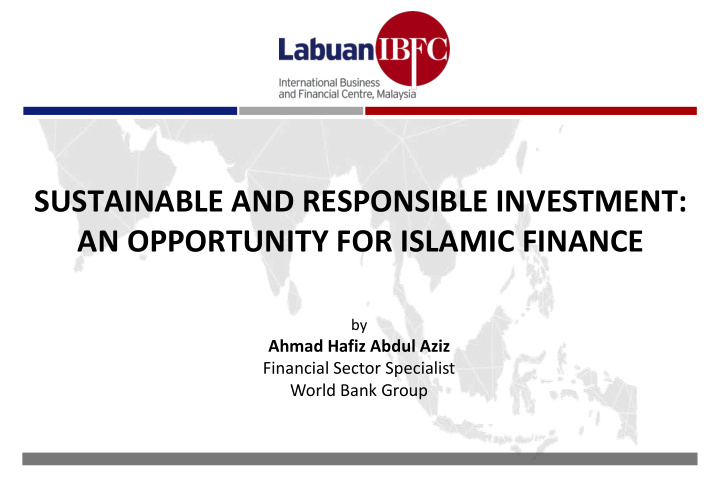



SUSTAINABLE AND RESPONSIBLE INVESTMENT: AN OPPORTUNITY FOR ISLAMIC FINANCE by Ahmad Hafiz Abdul Aziz Financial Sector Specialist World Bank Group
Global Policy Shifts Require Funding for SDGs and Climate Change • 17 global goals to achieve integrated sustainable development covering economic, social and environmental • UN estimated between USD 5tn and USD 7tn each year for the next 15 years to fund the 17 SDGs Paris Agreement on Climate Change • Global climate agreement to limit global warming to below 2 ° C • Will come into effect in 2020 • April 2016 – 177 nations signed the treaty, including Malaysia • US$100 billion per year by 2020 to help developing countries cope with climate change 2
Financing Needs to Realise the SDGs Estimated Annual Investment Requirements by SDGs Sectors 3 US $ Billion Source: UNCTAD, 2014
The Key Components of Financing Sustainable Development 4 Source: WBG, 2015
Growing Commitments Towards SRI No. of PRI Signatories and AUM 80 1900 1714 1501 70 1384 68.4 1400 1251 1186 60 62 1050 59 890 50 900 734 45 523 40 361 400 34 30 185 32 63 24 20 21 -100 18 10 13 10 6.5 0 -600 Apr-06 Apr-07 Apr-08 Apr-09 Apr-10 Apr-11 Apr-12 Apr-13 Apr-14 Apr-15 Apr-16 Apr-17 Assets under management (US$ trillion) Number of Signatories USD68.4 trillion assets managed by 1,700+ signatories to the UN PRI 5 Source: UN PRI
Growing Commitments Towards SRI Global SRI Assets (USD trillions) 22.9 18.3 13.3 2012 2014 2016 • USD22.89 trillion assets professionally managed under SRI strategies (CAGR: 11.9% over 2 years) • SRI now stands at 26% of all professionally managed assets globally • Negative/exclusionary screening is the largest approach with US$15.02 trillion or 65% of global SRI assets in 2016 6 Source: Global Sustainable Investment Alliance
Growing Commitments Towards SRI Number of Stock Exchange ESG Disclosure Guidance, 2004-2017 40 35 30 25 20 15 10 5 0 2004 2006 2008 2010 2012 2014 2016 2018 -5 • 2015: Launched of SSE Model Guidance and global campaign to promote ESG disclosure guidance • The Task Force on Climate-Related Financial Disclosures (FSB TCFD)’s recommendations highlight stock exchanges as one of the key stakeholders that can provide valuable contributions toward adoption of their recommendations 7 Source: Sustainable Stock Exchange (SSE)
Trends in Green Bonds 2012-2017 ✓ USD155.5bn - total green bond issuance ✓ Over 1500 green bond issues ✓ 78% - growth on 2016 ✓ 37 countries from all continents ✓ 239 different issuers ✓ 146 new issuers ✓ USD10.7bn – largest single green bond ✓ 4 Sovereign Green Bonds: Poland, France, Fiji, Nigeria 8 Source: Climate Bonds Initiative
Total Islamic Financial Assets Now Exceed USD 2 Trillion Global Islamic Finance Assets (USD Billion) 9
In Tandem, The Sukuk Market Has Also Expanded Substantially Global Sukuk Supply & Demand (USD Billion) Demand for sukuk has been surpassing the level of sukuk issuances worldwide 10 Source: Thomson Reuters
Global Sukuk Outstanding by Domicile as at End 2017 11
Global Islamic AUM by Domicile as at End 2017 Global Islamic AUM by Domicile 2017 Other 14% USA 3.1% Pakistan 3% Malaysia 36.5% Luxembourg 4.3% Jersey 11.2% Saudi Arabia 31.4% 12
Main Features of Islamic Finance 13 Source: IRTI-UNDP Report
Overlap Between the Objectives of Islam and the SDGs Life Progeny Wealth Objectives of Islam Protection Intellect of Faith 14
Similarities: SRI and Islamic Finance ▪ A value-based investment universe • Investment structures, investors associate themselves with a moral purpose: “doing good and avoiding harm to others” • Promote the wellbeing of all humankind – encourages investors to create positive non-financial value alongside financial returns to support a socially concerned, environmentally-friendly system • A broader understanding of the relationship between business and society 15
Differences: SRI and Islamic Finance SRI Islamic Finance General Holistic approach that aims to include any Values-based approach that mainly investment ESG information that could be material to focuses on exclusionary screens on approach investment performance. specific social and economic grounds. Strong emphasis on being active owners No widespread practice of engagement Active ownership and to engage with companies on ESG or active ownership. issues (including proxy voting). Sophisticated approach to analysing Avoiding financial structures of corporate entities investments in Not widely considered. to understand cash flows and avoid highly leveraged investments in companies with excessive companies leverage. Not widely considered, but there is a Shariah scholars assess the compliance of growing focus on environmental and financial products from a structural and Impact social impacts of investments (including legal perspective – the focus is not on contributions to the SDGs). actual impact or real economy outcomes. 16 Source: UN PRI
Opportunities for Islamic Finance • Expanding new sources of finance • Developing new markets • Enlarging the impact investing tools • Asset-backed nature of Islamic finance Non-SRI SRI Conventional investors + Conventional Bond conventional green investors • Broadest investor base investors Conventional Sukuk investors + Shariah- ALL investors compliant investors 17
WBG: Examples of Work in Islamic Finance 18
WBG: Greening the Financial Markets INDONESIA Next …. US$1.25 bn MALAYSIA Kazakhstan FIJI 100 mil FJD Nigeria Vietnam 6 green issues valued NGN 150 bn at USD1.06bn were lodged at SC between 6 June 2017 and 20 PT SMI March 2018 Morocco IDR 3 tn 19
Thank You
Disclaimer This document is prepared solely for the purpose of discussion only and shall not be shared with any third parties without written consent by both parties. The findings, interpretations, or recommendations expressed herein are those of the author(s), and do not necessarily reflect the views of the International Bank for Reconstruction and Development/The World Bank Group and its affiliated organizations, or those of the Executive Directors of The World Bank or the governments they represent.
Recommend
More recommend